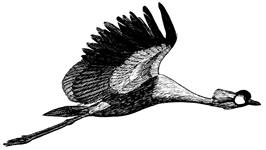Papers in the Biological Sciences
Date of this Version
January 1983
Abstract
Wherever cranes occur in the world, their stature, intelligence, wariness, and sociality have captured the human imagination and have given rise to a variety of legends, myths, and folktales. Among the best sources of such information for England and southern Europe are the manuscript writings of Edward Topsell (1572-1625), which have been edited and recently republished (1972). Topsell reported that "when fables ruled the world" it was believed that a proud queen of Pygmies named Oenoe or Gerania was turned into a crane by Juno and Diana, because she taught her people to neglect other gods and worship her. Gerania thereafter began an irreconcilable war between cranes and Pygmies that has persisted ever since. Much the same story appears in the Iliad of Homer. From this legend perhaps came the Greek name geranos or gereunos for cranes. Likewise, they were sometimes known as the birds of Palamedes, since, at about the time of the Trojan Wars, the mythic hero Palamedes reputedly invented several Greek letters by watching the convolutions of flying cranes. The avian genus Palamedea, however, was subsequently applied to the South American crane-like birds known as screamers. On the other hand, the Romans called cranes grues, evidently because of their grunting voices.


Comments
From Cranes of the World by Paul A. Johnsgard (Bloomington, IN: Indiana University Press, 1983; electronic edition: Lincoln, NE, 2008). Copyright © 1983 Paul A. Johnsgard.